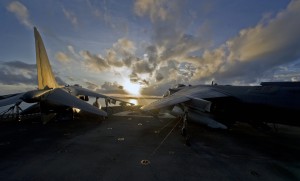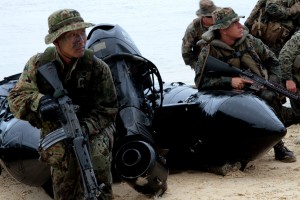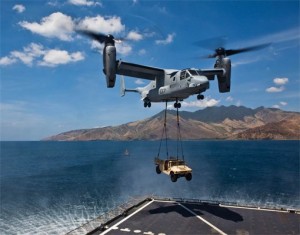2013-05-10 The 31st MEU has been preparing for a regular Osprey deployment in the Pacific to operate with them. They are following a proven route which the East Coast Ospreys and MEU rolls outs followed in the past few years.
During the past few months, 1st Marine Air Wing has provided Ospreys as part of the roll out process, but this summer, the Ospreys are going to become a regular feature of the 31st MEU operations.
SLD: What is the plan for Ospreys to come to the MEU?
Col. Merna: VMM 265 will be chopped to us later this month. We are going to ease into the deployment much as was done with the East Coast MEUs to ensure that we execute wisely with the Ospreys.
They will be part of our training with the Australians when we participate in Talisman Saber this summer.

We will be training with them as well at Bradshaw Field, which is a training area, and part of the rotational involvement of the Marines with the Australians. The training will contribute to the Australian effort to get ready to use their own forthcoming amphibious capability as well.
We are intending to operate with a full compliment of 10 Ospreys during the exercise, with 3 self-deploying from Okinawa, and we are steaming away with the rest of them. For us, the big deck amphibious ship will be the USS Bonhomme Richard.
SLD: This is part of the process whereby the Osprey will become a normal part of Pacific defense?
Col. Merna: It is. There are clearly political sensitivities in the region, but the Japanese forces find the capability of interest and we are working with the Japanese Ground Self Defense Force to familiarize them with the capability.
The Ospreys have made an impact in the region, and the options the aircraft provides us are significant.
For example, we can reach mainland Japan or the Philippines from Okinawa on one tank of gas, and, of course, with refueling the reach expands significantly. This will also give our large deck amphibs a significant operational advantage as the Ospreys come onboard in the Pacific.
SLD: The 31st MEU is different from the others in the USMC. Can you explain your approach?
Col. Merna: The 31st MEU is different from the other six in that it is the only continuously forward-deployed MEU in the USMC. The normal MEU rotation is 7-months out and then 14-months back. For us, we go out every 6 months. In other words, we have a more regular and constant presence in our area of operation and remain largely within the Asia-Pacific region.
We have to meet all of the usual METS or mission essential tasks as do all MEUs, but we perform them in a compressed timeline.
SLD: As the Japanese think through their evolving defense approach, they seem increasingly interested in the capabilities, which the USMC and its blue team partners bring to the table.
Col. Merna: They are. During the last two cycles of our deployments, we have embarked Japanese Ground Self-Defense Forces with us to become more accustomed with our operations. We integrate with them, we live with the, we train with them and certify with them. When we went to Thailand for an exercise, they came with us as well. They did remain aboard the ship during the exercise, it should be noted.
We are a maritime contingency force, which responds to any type of contingency ranging from humanitarian assistance to disaster relief to security operations and to higher end contingencies.
As such, we are key element in the Japanese perspective for their defense as well.

Being out in the Pacific and engaging regularly and consistently, the 31st MEU, is extremely important to our Asia-Pacific strategy, not just combat ops on the Korean Peninsula. It’s an across the board presence and capability.
And with additional capability like the UH1 Yankee, as well as the Osprey that we’re going to out with this cycle, we are improving our ability to execute our missions. And then, in the future, when we add the F-35B, this will give us is the type of equipment set, or capabilities that we need for both presence and mission success.
The new Zulus are another important contribution. They enable a longer time on station because of their greater endurance and increased power with their additional blades; their ability to operate longer and more effectively from a maintenance point of view is important as well.
SLD: When we visited the USS America, what struck us was the impact the ship will have notably on the aviation maintenance side. The ability to maintain the various air assets will be enhanced significantly by this ship. I realize that the ship will come after your time at the MEU, but from the standpoint of your experience, how does getting a ship that can sustain operations for a longer period of time matter?
Col. Merna: The America class will certainly bring us a lot more on the aviation maintenance side. It’s going to allow us to keep a much more capable ACE with the space and the spots it will have onboard. Right now, it’s a juggling match every day to manage the air assets. It is a challenge not only on the flight deck itself, but also in the maintenance bay and the hangar bay with regard to what goes up, and what goes down based on aircraft readiness and what needs additional work.
The America-Class is going to give us a whole lot more flexibility and really options for keeping a much higher readiness with our aircraft.
The space and then parts availability for those aircraft is going to increase tremendously. We’re going to have a lot more capable aviation combat element.
It will allow us to increase the number of aircraft, and fly a diversity of aircraft in support of the range of operations we do. We will particularly see an impact in mid-level operations, where the ACE is so fundamental to what we can achieve. The America-Class ship is really going to be beneficial when you start bringing in 11, 12 ships for a MEB level exercise or operation.
(For the importance of a MEB level capability see the recent interview with the leadership of the Bold Alligator 2013 exercise
https://sldinfo.com/bold-alligator-2013-crafting-a-21st-century-insertion-force/).
SLD: In many ways, the Osprey is the most visible example of the transformation of Marine Corps operations. The F-35B will be very significant, but for the average Pacific citizen, they will see the impact from the Osprey in very clear ways. Does that make sense to you?
Col. Merna: It does. When the next humanitarian assistance mission, disaster relief mission takes place in the Asia-Pacific, and we start impacting quickly, and immediately with relief supplies or people on the ground digging, filling sandbags, whatever it is helping somebody, all of our partners and allies in the Asia-Pacific region are going to see the immediate impact of the Osprey.
And when they start seeing that big old ugly bird come flying in and dropping off supplies from areas that we could not reach previously, or as rapidly, they’re going to see what they get out of the Osprey operating in their area.
SLD: And for the full range of missions, the F-35B will be most visible in the lower end missions as its C2 and ISR mapping capability becomes evident in such crises. That is why figuring out how to translate F-35B data to security operations will be a key requirement as well.
But let us go back to the upcoming exercise with the Australians. Could you discuss further?
Col. Merna: We’re going to go down there and will do some live fire training for about a week. We are demonstrating to the Australians the impact of an amphibious capability. We’re going to be able to take a battalion sized unit down the middle of nowhere, where there are saltwater crocs, there’s nasty bugs, it’s right in the middle of the outback that they very rarely use for military training.
And we’ll use Ospreys probably in an insertion role, and set up everything in a C2 structure from the sea. That’s the big piece here and if I can get the big deck to stick around, we’re going to demonstrate really for the first time, an amphibious operational area southwest of Darwin.
We would be operating in a large area.
The distance is around 400 miles and a minimum of 6 hours driving time but nearly two days convoy time as driven via USMC trucks. And then we’re off the coast 70 miles at sea. And we will support a battalion size element training live fire for about a week, across all classes of supply, and then get them back on the ships. And then, we’ll take off from there.
(The point about convoy time versus normal transit time is made by Murielle Delaporte from her time with the French forces in Mali.
https://sldinfo.com/the-french-in-mali-shaping-the-logistics-element-of-the-operation/).
We will be exercising the range and scope of amphibious operations today. We’re going to demonstrate an incredible capability across all classes of supply. We will be able to be heavy on the aviation footprint, light on C2, but with significant operational capability to cover a significant area of operation.

I think this is a pretty big deal if we can do at the end of September. The exercise will be with an Australian Defense Force company, one company from MRFD (Marine Rotational Force Darwin) and one company out of Battalion Landing Team (BLT) showing that we can do this combined bilateral exercise supported by amphibious capability. And we are doing this in a very remote austere training environment, which has not been done like this before in the area.
This will also help the Australians think through the potential use of their new amphibs ships and evolving operational concepts.
SLD: A final question would be how does the 31st MEU fit into the Pivot to the Pacific?
Col. Merna: In one sense, the Marines are going back to the force levels we had in the region prior to 9/11. So it is simply a restoration rather than a build up or buildout.
But the way the force is being configured is very different.
We are emphasizing building out a rotational force, notably in Australia, but elsewhere as well.
Because we are building out a rotational force, the new capabilities we are adding are crucial to success.
Rotational forces require greater capability for reach and speed, key aspects of the Osprey-F-35B combination coming to the Pacific.
The video above is from a recent Thai-US exercise.
During the combined arms live fire exercise, Marines and soldiers from both the Royal Thai Armed Forces and the U.S. military seized a simulated objective.
The live-fire exercise was conducted at Ban Dan Lan Hoi, Sukhothai province. The ground forces moved forward and seized an objective, completing the demonstration.
The event demonstrated the ability of a combined Thai-U.S. force, using both air and ground forces, to move rapidly to an objective and seize it.
Credit: 31st Marine Expeditionary Unit
2/21/13

